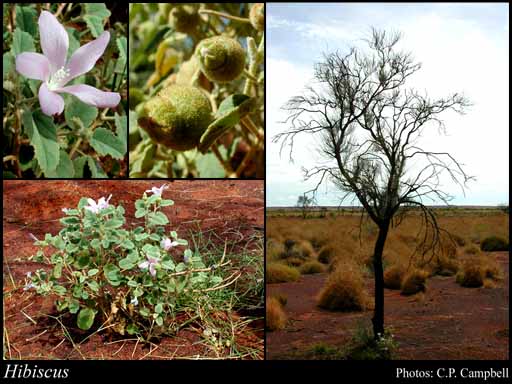- Reference
- Sp.Pl. [Linnaeus] 2:693 (1753)
- Name Status
- Current







Scientific Description
Common name. Hibiscuses. Family Malvaceae.
Tribe Hisbisceae.
Habit and leaf form. Small trees, or shrubs, or herbs (usually with a stellate indumentum). Plants unarmed. Annual, or perennial; to 0.1–4 m high. Mesophytic and xerophytic. Heterophyllous, or not heterophyllous. Leaves small to medium-sized; alternate; spiral; ‘herbaceous’, or leathery, or membranous; petiolate; non-sheathing; often compound, or simple; ternate, or palmate. Leaf blades dorsiventral; dissected (shallowly to deeply 3–7-lobed), or entire; ovate, or obovate, or oblong, or orbicular; pinnately veined, or palmately veined; cordate, or attenuate at the base, or cuneate at the base, or rounded at the base. Mature leaf blades adaxially pubescent, or glabrous; abaxially pubescent, or glabrous. Leaves with stipules (stipules subulate to linear). Stipules caducous, or persistent. Leaf blade margins entire, or crenate, or serrate. Leaf anatomy. Hairs present; complex hairs present. Complex hairs stellate. Extra-floral nectaries present (a basal nectary gland on the midrib of the lower surface of the leaf).
Reproductive type, pollination. Fertile flowers hermaphrodite. Unisexual flowers absent. Plants hermaphrodite. Entomophilous.
Inflorescence and flower features. Flowers usually solitary, or aggregated in ‘inflorescences’ (due to the reduction or abortion of the upper leaves); axillary; in racemes, or in panicles. Inflorescences axillary. Flowers pedicellate (pedicels usually articulate, at apex rarely thickened into an obconical or discoid hypanthium); medium-sized to large; regular; 5 merous; tetracyclic. Free hypanthium rarely present, or absent; obconic (or discoid). Hypogynous disk absent. Perianth with distinct calyx and corolla; 10; 2 -whorled; isomerous. Calyx present; 5; 1 -whorled; gamosepalous; lobed; lobulate (5-lobed); hairy; valvate; exceeded by the corolla; campanulate; regular; persistent; accrescent (in fruit). Calyx lobes ovate. Epicalyx present (of free or connate bracteoles, shorter than the calyx lobes). Corolla present; 5; 1 -whorled; polypetalous (adnate to the base of the staminal column); hairy abaxially, or glabrous abaxially; glabrous adaxially; with contrasting markings (usually with a different colour base); white, or yellow, or red, or pink, or purple. Petals obovate; clawed (usually ciliate or bearded). Androecium present. Androecial members indefinite in number. Androecium 50–100 (i.e. ‘many’). Androecial members adnate; all equal; coherent (connate; the filaments fused in a column surrounding the style); 1 - adelphous (the tube attached to the petals); 1 -whorled. Androecium exclusively of fertile stamens (or rather, half-stamens, each having only a half anther). Stamens 50–100; becoming exserted, or remaining included. Anthers dehiscing via longitudinal slits; introrse; unilocular. Gynoecium 5 carpelled. The pistil 5 celled. Gynoecium syncarpous; synstylovarious to eu-syncarpous; superior. Ovary plurilocular; 5 locular. Gynoecium stylate. Styles 5; more than 4-branched (connate for much of their length, then distally divided into 5 spreading branches); apical; becoming exserted. Stigmas 5; capitate (or discoid). Placentation axile. Ovules 3–50 per locule (i.e. 3-numerous).
Fruit and seed features. Fruit 5–25 mm long; non-fleshy; cream; hairy, or not hairy; dehiscent; a capsule (ovoid to globular). Capsules loculicidal (by 5 valves). Dispersal unit the seed. Fruit 50–100 seeded (i.e. ‘many’). Seeds endospermic (much reduced); not compressed (reniform in outline); small; conspicuously hairy, or not conspicuously hairy (or with microscopic scales).
Geography, cytology, number of species. World distribution: pantropical and subtropical. Native of Australia. Not endemic to Australia. Australian states and territories: Western Australia, South Australia, Northern Territory, Queensland, New South Wales, Victoria, and Australian Capital Territory. Northern Botanical Province and South-West Botanical Province. 2n = 36 for H. cannabinus; 2n = 108 for sect. Furcaria; H. arnhemensis, H. byrnensis, H. heterophylla, H. menzeliae, H. meraukensis, H. spinulosus, H. splendens and H. symonii. A genus of c. 300 species; 27–32 species in Western Australia; 7 endemic to Western Australia.
Etymology. From the Greek hibiscos (marsh-mallow), Althaea officinalis.
Taxonomic Literature
- Grieve, B. J.; Blackall, W. E. 1998. How to know Western Australian wildflowers : a key to the flora of the extratropical regions of Western Australia. Part II, Dicotyledons (Amaranthaceae to Lythraceae). University of W.A. Press.. Nedlands, W.A..
- Wheeler, J. R.; Rye, B. L.; Koch, B. L.; Wilson, A. J. G.; Western Australian Herbarium 1992. Flora of the Kimberley region. Western Australian Herbarium.. Como, W.A..